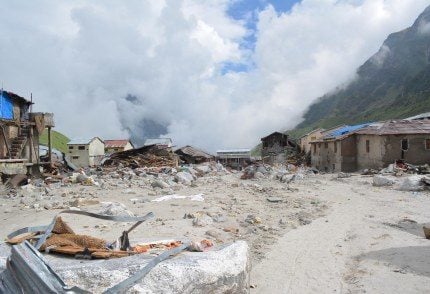Scientists have been warning that the frequency of floods, droughts and storms will go up due to climate change. The large number of flash floods across the Hindu Kush Himalayas this summer appears to be proving their point. So how should policymakers respond right now?
Experts and activists gathered at a recent workshop held in New Delhi to discuss the worst of this year’s flash floods – in Uttarakhand – stressed the need to urgently install early warning systems so that people could get out of the way. The workshop was organised by the Times of India media group.
The experts pointed out that the entire Himalayan belt in India is prone to such disasters, especially since the weather has started behaving quite erratically. “The disaster in Uttarakhand was caused by floods. Did we have early warning systems? No we didn’t have,” said Vijay Kumar, operations manager of Danish Hydraulics Institute. He added that the losses could have been minimised if there was a warning system in place.
Disaster warning systems in the Himalayas
“If you have modern technological support like satellite data and radars, you will be able to quantitatively forecast rainfall; and once you know this, you can start warning the people in advance which will greatly help, avoiding huge loss of life. Since water reservoirs for generating power in most parts of the Himalayas either already exist while many more are coming up, this kind of forecasting system has to be in place across the Himalayas,” Kumar said. “The information about a likely flood event can be sent to mobile phones and radio stations so that people can start safeguarding their lives.”
L.M.S. Palni, former director of the G.B. Pant Institute of Himalayan Environment and Development, stressed that an integrated policy for the entire Himalayan region was the need of the hour. “A new policy for the entire Indian Himalayan region which consists of 10+2 Himalayan states (10 entirely mountainous states and two other states, whose parts have been designated by Planning Commission of India as mountainous) should be formed,” Palni said.
The design for development
Palni pointed out that Himalayan states with geographic peculiarities like that of Uttarakhand need to have specific development designs. “In the Planning Commission policies, most of the designing of the development for mountainous states is present, but unfortunately it has never been implemented,” he observed.
According to Palni, a 2010 Planning Commission report said that river valleys should be given the status of sacred nature, but all development is taking place along river valleys. “A commission should be made to probe as to why development designs of the Planning Commission have not been adhered to in Himalayan states,” he demanded.
“In case of Uttarakhand, Dev Bhoomi (the land of gods) has been converted into Paratakh Bhoomi (the land of tourism). We need to think very seriously on this.”
Kashmir and Himachal Pradesh
Days after the devastation in Uttarakhand by floods, another Himalayan region, Himachal Pradesh, was struck by serious flooding. Though no loss of life was reported, the floods damaged property worth millions of dollars. Experts say that such events are going to become routine in future in the wake of climate change.
Experts in Kashmir in the Himalayas have warned that the southern part of the valley is vulnerable to a serious disaster if any extreme meteorological event occurs.
“The Uttarakhand tragedy has rung alarm bells for the entire Himalayan belt considering its fragile ecology. Since we are the part of the same fragile Himalayan belt, any extreme meteorological event can create havoc here as well,” said Mohammad Sultan, head of the Department of Geography and Regional Development in Kashmir University. Sultan recently headed a team of researchers who carried out a comprehensive study on the Lidder river’s catchment area in southern Kashmir by studying the impact of human activities in this ecologically fragile area.
Since the Uttarakhand tragedy was triggered by the outburst of glacial lakes, Pahalgam, a popular tourist destination on the Lidder river is also vulnerable to such catastrophes, said Sultan, “As we have a reasonable presence of glacial lakes in the upper reaches of Pahalgam.” In the event of complex meteorological developments, “The glacial lakes in the upper reaches of Pahalgam have the vulnerability to burst.”
The demand for taking measures to protect the Himalayas is being made periodically since 2010, the year when September 9 was declared to be Himalayan Day in India. Environmental activists including Sundar Lal Bahugana and Anil Joshi have been demanding that a separate ministry be set up by the Indian government to take care of the Himalayan mountain system.

